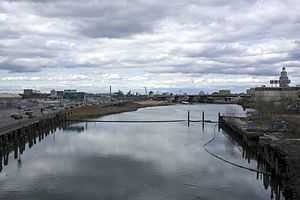Flushing River

The Flushing River, more properly and historically known as Flushing Creek, is a waterway that flows through the northern part of central Queens in New York City, emptying into the East River. The river is located in a valley that may have been a larger riverbed prior to the last Ice Age, neatly dividing Queens into a western and an eastern half, and in the 18th and 19th centuries it divided the towns of Flushing on its right bank and Newtown on its left.
The channel
The headwaters of Flushing Creek were once located in the present-day neighborhood of Kew Gardens Hills, where Vleigh Place traces the Vleigh (old Dutch for Valley) of the headwaters. In the larger valley that comprises the present-day Flushing Meadows-Corona Park, the creek meandered through salt marshes, collecting water from Fly and Ireland Creeks and Horse Brook before emptying into Flushing Bay on the East River. The area near the mouth of the creek became the site of the early Flushing settlement.
History
The town of Flushing was first settled in 1645 under charter of the Dutch West India Company and was named after the port of Vlissingen, in the southwestern Netherlands. It is said that the name Vlissingen means "salt meadow," given as a nod to the tidal waters of Flushing Meadows. As the English version of the name of the Dutch town is "Flushing", the same English version was used by the town's English-speaking inhabitants. During his presidency, George Washington arrived at Flushing by ferry across the creek. The first road crossing, a drawbridge at Northern Boulevard, was built in the early 19th century.[citation needed]
By the 1850s, a second crossing, Strong's Causeway was built near the present-day Long Island Expressway, extending Corona Avenue towards Flushing. This crossing was located near the confluence of Horse Brook and Flushing Creek. In the mid-19th Century, the growing city of Brooklyn acquired the land around the creek and gave it for use to the Brooklyn Ash Removal Company, which turned the salt marshes into landfill. The pollution was chronicled by F. Scott Fitzgerald in The Great Gatsby, wherein Nick Carraway observed the "valley of ashes" on his train ride between Manhattan and Long Island.[citation needed]
In 1936, Robert Moses proposed closing the ash landfill and transforming it into a park through its use as a World's Fair site. With the exception of the so-called Willets Point triangle, the landfill was leveled, the creek bed was straightened, and the southern part of the creek was deepened to form the Meadow and Willow Lakes at Flushing Meadows–Corona Park. At its northern section, a tidal gate bridge was built to keep the East River tide from flooding into the park. By then, Horse Brook was long gone, its course destined to be covered by the future Long Island Expressway. Ireland Creek was also filled in for use as parkland to prevent flooding in the surrounding neighborhoods. Dammed and reduced in size, the creek became navigable only up to Roosevelt Avenue. Barges still docked on the river, bringing sand and gravel. At its southern end, the Jamaica subway yard reduced some of the flow coming from the headwaters.[citation needed]
For the 1964 New York World's Fair, the creek was further reduced, when its middle section was filled in for parkland. Flowing out of Meadow Lake, the creek was reduced to a canal beneath the Van Wyck Expressway, narrowing into pipes going into the Fountain of the Planets, a circular pool used for fountain displays. From there, the pipes took the water towards the tidal bridge, reemerging as a creek.[citation needed]
Over the years, pollution from the Willets Point industrial area, surrounding highways, and dumping made the river an eyesore and a health hazard. In 2002, a sewage treatment plant was completed near College Point Boulevard, and the city took stronger enforcement measures against industries in Willets Point.[citation needed]
Restoration
As other waterways in New York have seen their shores revitalized with parks, the mid-20th century waterfront promenade along Flushing Bay to LaGuardia Airport was renovated and reopened in 2001. The success of this project led to calls for a similar waterfront promenade less than a mile upstream near downtown Flushing. There are also ongoing plans by the city to raze the industrial buildings of Willets Point in favor of a convention center and hotels.
Among the more ambitious proposals is one to reopen the buried parts of Flushing Creek to daylight, which would mean closing two soccer fields, and altering the park's small "pitch and putt" golf course. At Meadow Lake, the abandoned Aquacade arena from the 1939 World's Fair has been demolished in favor of a pier with a sitting area, however the boathouse is still in use. At the creek's source, Willow Lake, nature trails paved decades ago remain overgrown with plants, and are currently closed to the public.
Merger of the lakes
The New York City 2012 Olympic bid proposed merging the two lakes, with a new bridge at Jewel Avenue. The proposal generated community opposition, citing aesthetics in the proposed lake's rectangular shape; traffic and lack of public access during the games, loss of parkland, and disruption to wildlife living in Willow Lake. Failing to secure its bid, the city has since shelved plans to unite the lakes.
See also
- List of rivers in New York
External links
Coordinates: 40°45′35″N 73°50′15″W / 40.75972°N 73.83750°W